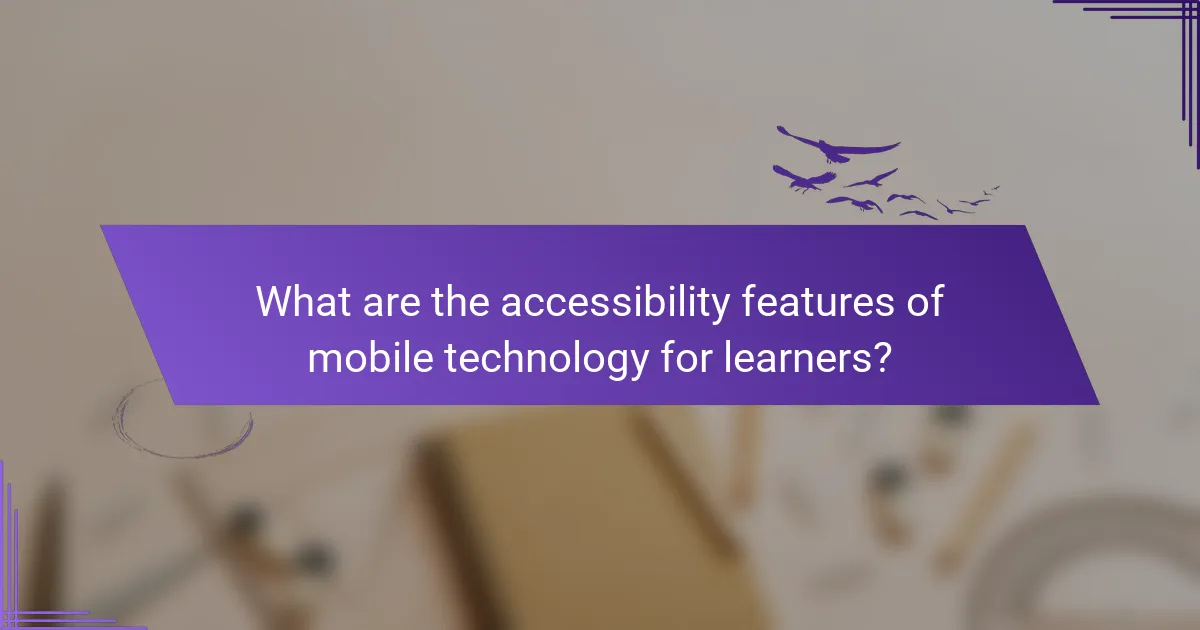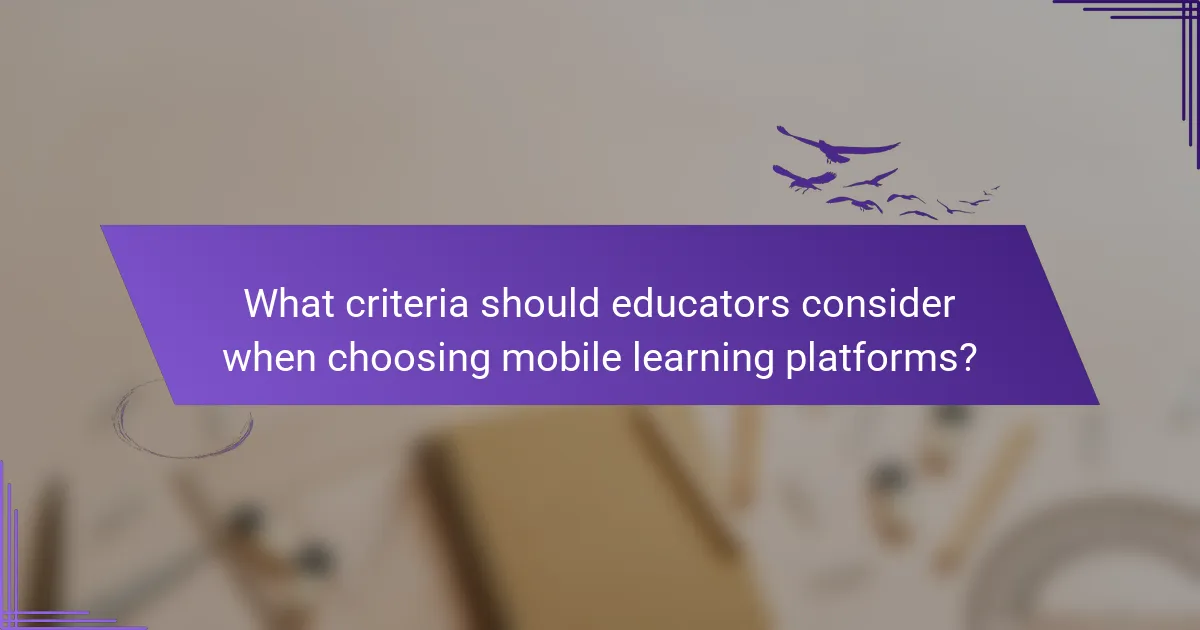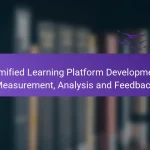Mobile technology plays a crucial role in enhancing engagement and accessibility in education, allowing students to access learning materials anytime and anywhere. By incorporating interactive features and tools designed for individuals with disabilities, mobile platforms foster a more inclusive learning environment. This flexibility not only encourages active participation but also significantly improves learning outcomes by enabling learners to interact with content at their own pace.

How does mobile technology enhance engagement in online courses?
Mobile technology enhances engagement in online courses by providing flexible access to learning materials and interactive features that keep students involved. With the ability to learn anytime and anywhere, students are more likely to participate actively in their education.
Interactive learning tools
Interactive learning tools, such as quizzes, polls, and discussion forums, allow students to engage directly with the content and their peers. These tools can be easily integrated into mobile platforms, making it simple for learners to participate in real-time discussions or complete interactive assignments on the go.
For instance, platforms like Kahoot! and Quizlet offer mobile-friendly interfaces that encourage participation through gamified quizzes and flashcards. This interactivity not only boosts engagement but also reinforces learning through immediate application of concepts.
Real-time feedback mechanisms
Real-time feedback mechanisms enable students to receive instant responses to their work, which is crucial for maintaining engagement. Mobile applications can provide immediate grading on quizzes or assignments, allowing learners to understand their performance and areas for improvement without delay.
Additionally, features like chatbots or messaging systems can facilitate quick communication between students and instructors, helping to clarify doubts and enhance the learning experience. This immediacy fosters a more dynamic and responsive educational environment.
Gamification elements
Gamification elements, such as points, badges, and leaderboards, can significantly increase student motivation and engagement in online courses. By incorporating game-like features, learners are incentivized to complete tasks and participate actively in their courses.
For example, platforms like Duolingo use gamification to encourage language learning through levels and rewards, making the process enjoyable and competitive. This approach can lead to higher retention rates and improved learning outcomes as students strive to achieve their goals.

What are the accessibility features of mobile technology for learners?
Mobile technology offers various accessibility features that enhance learning for individuals with disabilities. These features include tools that improve navigation, communication, and interaction with educational content, making learning more inclusive.
Screen reader compatibility
Screen readers are essential for learners with visual impairments, as they convert text on the screen into speech. Most mobile devices support popular screen readers like VoiceOver for iOS and TalkBack for Android, allowing users to access educational apps and websites effectively.
When selecting educational content, ensure it is compatible with screen readers by checking for proper HTML structure and alternative text for images. This compatibility enhances the overall learning experience for visually impaired students.
Voice recognition software
Voice recognition software allows learners to interact with their devices using spoken commands, which is particularly beneficial for those with mobility challenges. Applications like Siri and Google Assistant can help users dictate text, navigate menus, and control device functions hands-free.
To maximize the effectiveness of voice recognition, users should speak clearly and use simple commands. Familiarity with the software’s capabilities can significantly enhance productivity and engagement in learning activities.
Customizable user interfaces
Customizable user interfaces enable learners to adjust settings according to their specific needs, improving accessibility. Features such as adjustable text size, color contrast options, and simplified layouts can help users with various disabilities navigate content more easily.
Encourage learners to explore their device settings to personalize their experience. For instance, increasing text size or enabling high-contrast modes can make reading materials more legible and engaging for students with visual impairments.

How does mobile technology impact learning outcomes?
Mobile technology significantly enhances learning outcomes by providing flexible access to educational resources and fostering engagement. This accessibility allows learners to interact with content at their own pace, leading to improved understanding and retention.
Improved retention rates
Mobile technology facilitates improved retention rates by enabling learners to revisit materials anytime and anywhere. This on-demand access encourages spaced repetition, a proven method for enhancing memory retention. For example, students can review lecture notes or educational videos during commutes or breaks, reinforcing their learning.
Additionally, interactive elements such as quizzes and gamified learning experiences on mobile platforms can further solidify knowledge retention. Engaging with content through various formats helps cater to different learning styles, making it easier for students to remember information.
Increased course completion rates
Mobile technology contributes to increased course completion rates by offering learners the flexibility to study on their own schedule. This convenience is particularly beneficial for adult learners balancing work and family commitments, as they can access course materials during free moments.
Moreover, mobile platforms often include features like reminders and progress tracking, which motivate learners to stay engaged and complete their courses. Institutions that implement mobile-friendly courses can see completion rates rise significantly, often by double-digit percentages.
Enhanced collaborative learning
Mobile technology enhances collaborative learning by allowing students to connect and communicate easily through various applications. Tools like discussion forums, group chats, and shared documents enable real-time collaboration, regardless of location.
For instance, students can work together on projects using mobile apps that support file sharing and video conferencing. This collaborative approach not only fosters teamwork but also enriches the learning experience, as students can learn from each other’s perspectives and insights.

What are the best practices for integrating mobile technology in online courses?
Integrating mobile technology in online courses involves using effective strategies to enhance learning experiences. Key practices include ensuring responsive design, optimizing content for mobile devices, and conducting regular user testing to gather feedback.
Responsive design principles
Responsive design is crucial for ensuring that online courses are accessible on various mobile devices. This approach allows content to adapt seamlessly to different screen sizes, enhancing user experience and engagement.
To implement responsive design, utilize flexible grids, images, and CSS media queries. This ensures that text and interactive elements are easily readable and navigable on smartphones and tablets.
Content optimization for mobile
Content optimization for mobile involves tailoring educational materials to suit smaller screens and touch interfaces. This includes simplifying navigation, using concise text, and incorporating multimedia elements that load quickly.
Consider breaking down complex information into smaller, digestible chunks. Use bullet points and visuals to maintain engagement and facilitate easier comprehension on mobile devices.
Regular user testing and feedback
Regular user testing and feedback are essential for refining mobile course experiences. Engaging real users helps identify usability issues and areas for improvement, ensuring that the course meets learners’ needs.
Conduct testing sessions with a diverse group of users and gather feedback through surveys or interviews. This iterative process allows for continuous enhancements based on user experiences, leading to better learning outcomes.

What criteria should educators consider when choosing mobile learning platforms?
Educators should focus on user accessibility, content delivery methods, and analytics capabilities when selecting mobile learning platforms. These criteria ensure that the platform meets diverse learner needs, effectively delivers educational content, and provides insights into learning outcomes.
User accessibility features
When evaluating mobile learning platforms, consider the accessibility features they offer. Look for options such as screen readers, voice commands, and adjustable text sizes to accommodate learners with disabilities. Platforms compliant with standards like WCAG (Web Content Accessibility Guidelines) are often more inclusive.
Additionally, check if the platform supports multiple languages and provides alternative formats for content, such as audio or video. This can enhance engagement for a broader audience, including non-native speakers and those with different learning preferences.
Content delivery methods
Content delivery methods are crucial for ensuring effective learning experiences. Platforms should offer a mix of synchronous and asynchronous learning options, allowing students to engage with materials at their own pace or in real-time with instructors. This flexibility can cater to various learning styles and schedules.
Consider whether the platform supports multimedia content, such as videos, interactive quizzes, and discussion forums. These elements can enhance engagement and retention, making learning more dynamic and effective.
Analytics and reporting capabilities
Analytics and reporting features help educators track student progress and engagement. Look for platforms that provide detailed reports on learner performance, such as completion rates, assessment scores, and time spent on tasks. This data can inform instructional strategies and identify areas needing improvement.
Ensure the platform allows for easy access to these analytics and offers customizable reporting options. This can help educators tailor their approaches based on real-time insights, ultimately improving learning outcomes for all students.


